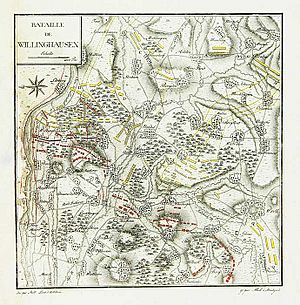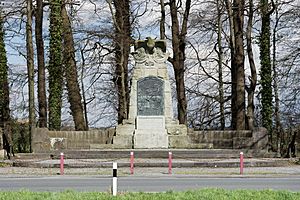Battle of Villinghausen facts for kids
Quick facts for kids Battle of Villinghausen |
|||||||
|---|---|---|---|---|---|---|---|
| Part of the Seven Years' War | |||||||
 Bataille de Willinghausen, print, Frankfurt 1789 |
|||||||
|
|||||||
| Belligerents | |||||||
| Commanders and leaders | |||||||
| Strength | |||||||
| ~65,000 | ~90,000 | ||||||
| Casualties and losses | |||||||
| 1,400 | 5,000 (Broglie 4,700, Soubise 300) | ||||||
The Battle of Villinghausen was an important fight during the Seven Years' War. It happened on July 15th and 16th, 1761, in what is now western Germany. This battle was between a large French army and a combined force of British and German soldiers. The Anglo-German force was led by Prince Ferdinand of Brunswick.
Contents
Why the Battle Happened
In July 1761, two French armies joined together. They were led by two Marshals, Duc de Broglie and Prince de Soubise. Their goal was to push Prince Ferdinand out of Lippstadt. This town was very important for controlling the area.
Prince Ferdinand's army had about 65,000 soldiers. The combined French armies were much larger, with around 90,000 soldiers.
How the Battle Unfolded
The Anglo-German forces set up their defenses along some hills. Their left side was protected by the Lippe River to the north. The Ahse River was in the middle of their lines.
On July 15th, the French army attacked. Broglie's troops, on the northern side, made some progress. They pushed back the German soldiers there. However, British troops led by Granby held their ground. This stopped the French attack.
That night, both sides received more soldiers. Prince Ferdinand made his left side stronger. He moved some troops from his right side to do this.
The next morning, Broglie continued his attack on the Allied left. He expected Soubise to attack the weaker Allied right side. But Soubise only made a few small attacks. This was partly because both French commanders had the same rank. They didn't want to take orders from each other.
Soon, more Allied soldiers arrived along the Lippe River. They attacked the French from the side. This stopped Broglie's attack completely. His men were forced to pull back. By about noon, the French were fully retreating, and the battle was over.
What Happened After the Battle
When news of the victory reached Britain, people were very happy. This made William Pitt, a key British leader, take a stronger stance. He became tougher in the peace talks with France.
Even though they lost, the French still had many soldiers. They continued their attacks, but their two armies split up again. They started working on their own. The French tried to keep fighting in Germany. However, they were pushed back. By 1762, they had lost the important town of Cassel.
The Treaty of Paris officially ended the war. This treaty made France leave all the German land they had taken during the war.
See also
Sources
- Military History Encyclopedia
- BritishBattles.com


